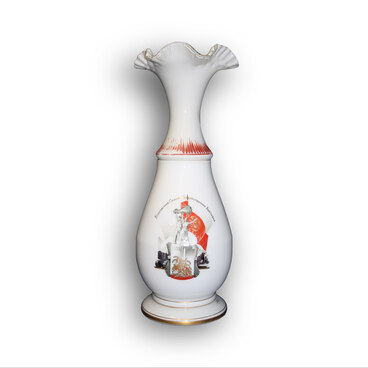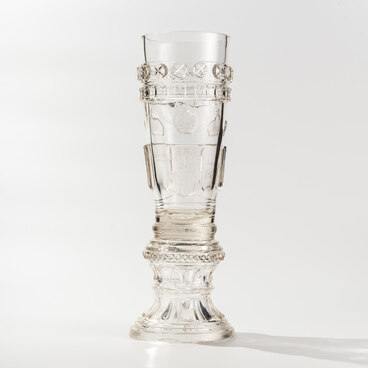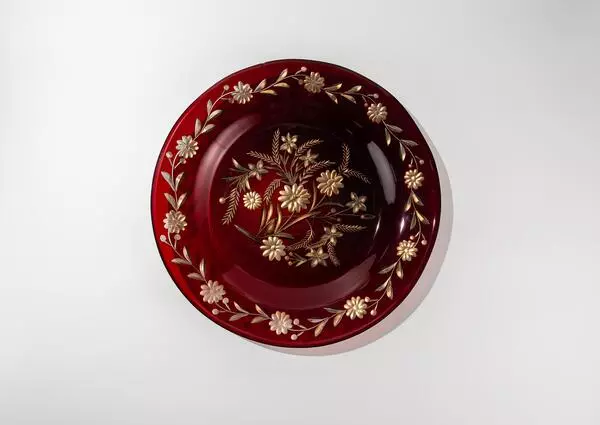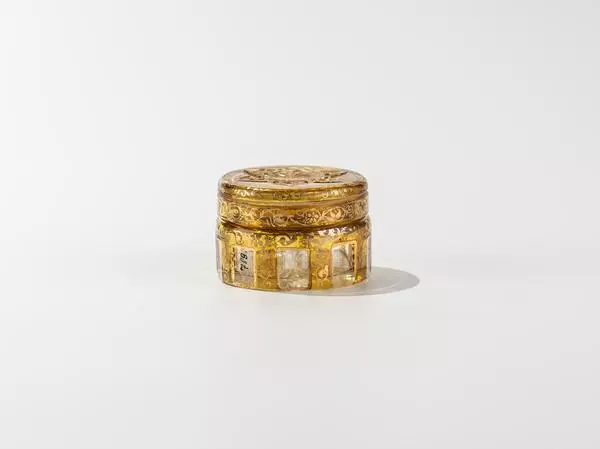The complex and multi-component “Fishbowl” vase is one of the best works created by the artist Anna Lipskaya (1902–1981) at the Dyatkovo Crystal Factory.
The decorative vase consists of two parts. The outer part was blown using transparent crystal and decorated with deep wave-like cuts as well as the transparent fish silhouettes cleverly integrated into the seemingly moving surroundings. The deep diamond-shaped cutting was not typical of the 1950s when products were usually decorated with a small dense pattern. The inner part of the vase is a large glass with cut festoony edges. It is made of frosted light-green glass with gold images of fish and algae. The colored part of the vase is inserted into the colorless section to create a unique optical illusion of imitating an aquatic environment. The inner part of the vase shows a smooth transition from a darker color imitating the bottom water to a lighter surface layer as if lit by the beams of sunlight. This effect is achieved by using two-layer glass (the upper layer being green and the lower one — transparent) and the subsequent processing of the surface with hydrofluoric acid. The transition from the darker to the lighter color is proportional to the intensity of the acid treatment of the glass. In Russia, this deep etching technique is often called the Gallé technique after the French artist Émile Gallé (1846–1904).
The gold painting was applied to special cavities in the vase’s surface which adds volume to the fish scales and algae stems. Liquid gold is applied manually, using a soft brush. It is a heavy dark-brown solution of gold in a complex organic solvent. After the liquid gold dries up, a glossy brown film can be seen on the surface. The golden color appears later, only after the annealing process. Applying gold to cavities helps to prevent it from wearing off. The artistic qualities of this vase make it one of the most innovative glassware products of its time.
The decorative vase consists of two parts. The outer part was blown using transparent crystal and decorated with deep wave-like cuts as well as the transparent fish silhouettes cleverly integrated into the seemingly moving surroundings. The deep diamond-shaped cutting was not typical of the 1950s when products were usually decorated with a small dense pattern. The inner part of the vase is a large glass with cut festoony edges. It is made of frosted light-green glass with gold images of fish and algae. The colored part of the vase is inserted into the colorless section to create a unique optical illusion of imitating an aquatic environment. The inner part of the vase shows a smooth transition from a darker color imitating the bottom water to a lighter surface layer as if lit by the beams of sunlight. This effect is achieved by using two-layer glass (the upper layer being green and the lower one — transparent) and the subsequent processing of the surface with hydrofluoric acid. The transition from the darker to the lighter color is proportional to the intensity of the acid treatment of the glass. In Russia, this deep etching technique is often called the Gallé technique after the French artist Émile Gallé (1846–1904).
The gold painting was applied to special cavities in the vase’s surface which adds volume to the fish scales and algae stems. Liquid gold is applied manually, using a soft brush. It is a heavy dark-brown solution of gold in a complex organic solvent. After the liquid gold dries up, a glossy brown film can be seen on the surface. The golden color appears later, only after the annealing process. Applying gold to cavities helps to prevent it from wearing off. The artistic qualities of this vase make it one of the most innovative glassware products of its time.




